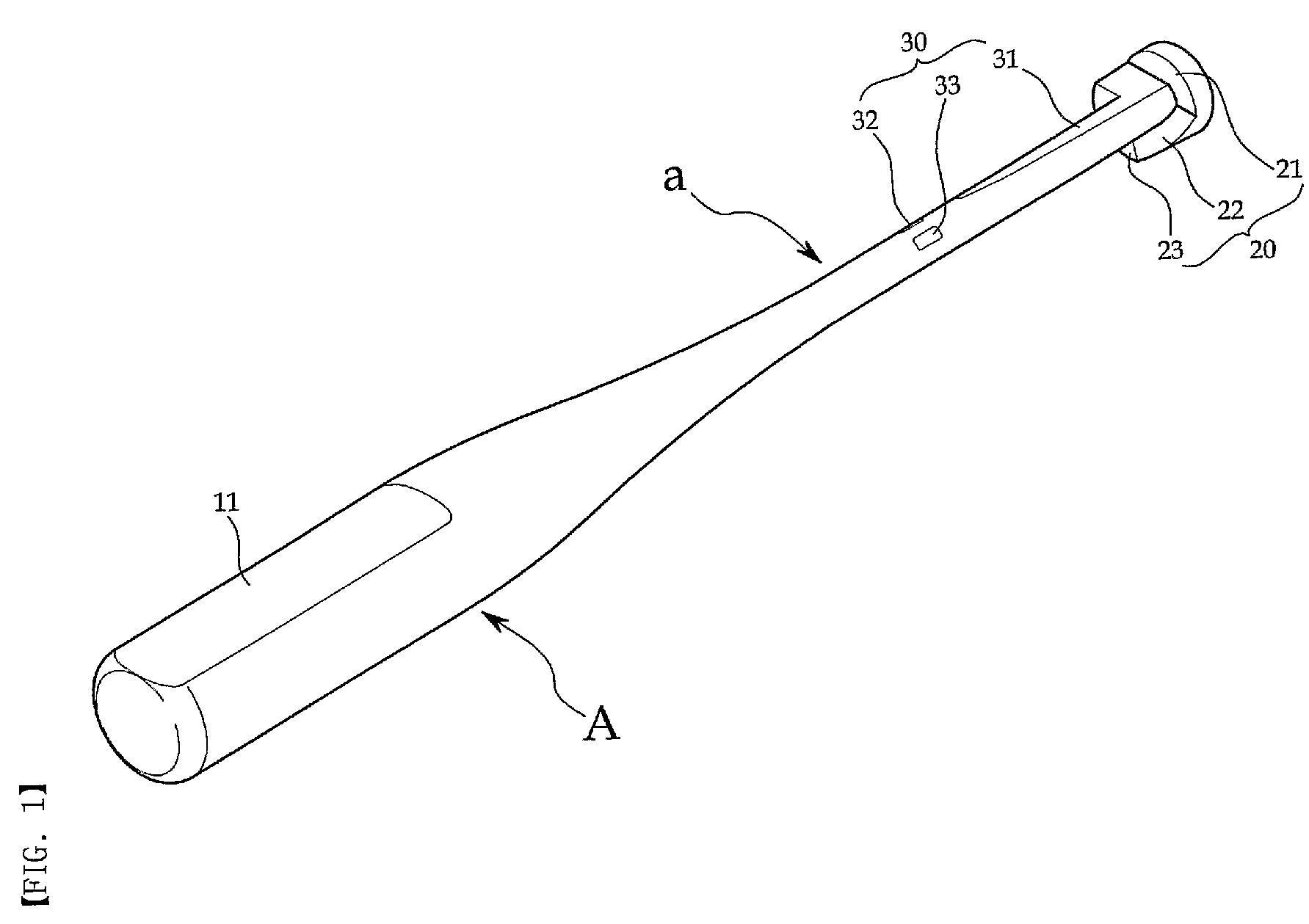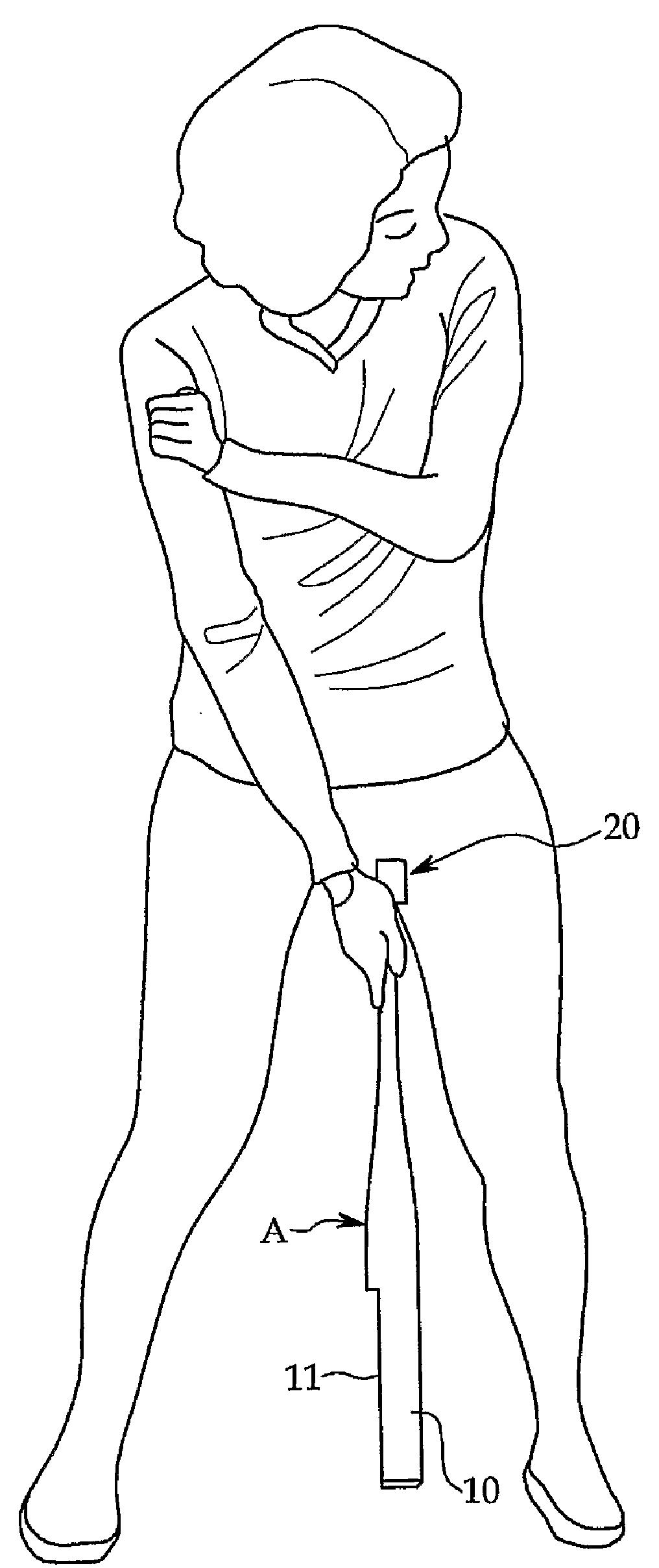Hot New Golf Swing Practice Device or Next Big Flop?
Any patent applications including “golf-bat” in the title get my immediate attention. This week a patent application published with the title “Golf-Bat for Centrifugal Golf Swing” (US Pub. No. 20090054171).
The application describes the invention as:
A golf swing practice bat is provided. The bat includes a barrel (10), a stop (20), and a grip portion (30). The barrel (10) is disposed on one end of a stick-shaped body of a predetermined length (a), and has an equal diameter from the end down which narrows in diameter toward its base and a trajectory indicator (11). The stop (20) has a predetermined width to rest an outer edge of a left hand on. The grip portion (30) is disposed between the barrel (10) and the stop (20). When practicing golf swings using the bat, a user benefits from the proper grip positioning structure of the bat, can execute a forceful swing without excessive gripping force for less stiffness in the arms, and can visually check swing trajectory using the trajectory indicator (11) to achieve a powerful, centrifugal, textbook swing.
Check out these drawings:


The application explains (bear with some odd sentence structure, probably some translation issues):
[0002] Having recently grown popular among many people, golf is a sport that provides a unique enjoyment and exercise benefits, and involves striking a stationary ball with a driver, iron, putter, or other club towards a hole cup that is a certain distance away.
[0003] In order to enjoy golf and elevate the level of one’s game, it is necessary to have a proper grip that forms the basis for an accurate swing and to learn to use one’s entire body and acquire a sense of balance for an adequately powerful and centrifugal stroke. To accomplish this, one must read theory and instruction manuals, and invest countless hours of practice. This applies to beginners as well as those of an intermediate level who wish to maintain a learned golfing stance and stroke or improve thereupon.
[0004] A golf grip consists of joining the left and right hands together to overlap, interlock, form a baseball grip, etc., depending on the preference of a player. An ideal swing involves both hands moving as one, with a precise grip and grip pressure unwavering throughout the swing, and transferring the force from a pivotal movement of a body to a fast, swinging motion of a club head. When a user does not grip a club properly, it detracts from the golfer’s concentration during a swing, and leads the golfer to try to execute the swing with the hands and arms. This is a problem common among amateurs, which often remains uncorrected during a lifetime. A golfer should, in reality, not even think about the grip during a swing. Points that require concentration are pivoting the torso quickly and executing a balanced stroke. The shoulders and arms should not be stiff, rotation of the torso should be smooth and supple, and the hands at the ends of the arms should function as firm anchors to secure the club during the swing. A point to note here is that concentration should not dwell on the grip, which is only possible with a complete understanding of the function of each gripping portion of the hands.
[0005] A golf swing consists of a back swing, a transition, a downswing, a follow-through, and a finish. The swing is an action that involves an integrated and dynamic rotation of the lower and upper torsos from a balanced stance, so that an axis at the center of the torso can be perceived, the axis being the centripetal locus of the torso. When a swing is executed with the centripetal locus in mind, the trajectory of the club head at the tip of the swing path moves in a circular arc with an even trajectory, and thereby forms an ideal swing.
[0006] In order for the body to grow accustomed to this type of swing or for a beginner to improve to an intermediate level, devices for practicing gripping and swinging are used. Professional golfers regard practice devices as indispensable tools for fostering muscle memory and muscular development.
[0007] Conventional gripping practice devices include devices for guiding proper hand placement only, or in some cases, devices that foster completely improper hand placement while claiming to be practice devices for learning a proper grip. These devices, which focus on only an outwardly proper placement of the hands or a grip feel, fail to consider the most intricate and difficult aspect of attaining a proper grip, which is that without an understanding of the function of each gripping part of the hands, the learning of a proper grip can be adversely affected. Similarly, conventional grip practice devices lead to a vague sense of hand positioning that inhibits the understanding of the function of each gripping part of the hands.
[0008] Along with the importance of understanding the function of each gripping part of the hands, the most important aspect of a good grip is that gripping pressure of the two hands should remain adequate and unchanging throughout a swing. Conventional grip practice devices do not foster learning of an adequate and unchanging gripping pressure by two hands throughout a swing. Therefore, many golfers need a practice device for mastering a grip with an unwavering gripping force. Such a device has actually been proposed, but the results have been unsatisfactory. One such device in question uses a sensor on the grip to emit a sonic alert if the grip pressure should change during a swing. However, this device only outlines the outer form of the grip, and fails to provide an understanding of each grasping portion and the relationship between the torso and the arms during a swing, and can therefore be discounted as a valid practice device for improving a swing.
[0009] Other conventional practice devices that are weighted focus on muscular development for power or practicing a specific swing trajectory. However, such devices require a firmer gripping force, and condition a user to exert varying gripping force during a swing, leading to swing execution that relies heavily on the hands and arms so that a centrifugal swing is eluded. This is like torching a house to catch a bedbug.
[0010] Also, conventional swing practice devices do not easily allow the checking of a swing trajectory during the stages of the swing, thereby leading to constant doubt regarding the swing plane. Even if there are devices for changing one’s swing trajectory, these are reliant upon practice using partial strokes, versus normal full-speed swings, so that when a real swing is executed, it seldom resembles the practiced strokes. In addition, many amateurs fail to realize that a faulty back swing leads to many other problems.
[0011] Finally, conventional swing practice devices lack an accompanying manual that is detailed, so that the effects of use are unclear. Specifically, because most practice devices lack user manuals, there is little feedback pertaining to the method of use initially envisioned by the developer and the results of that use. Such devices are therefore explored by a handful of users and abandoned before they can become widespread. The latter is a very important point because golf practice devices should always come with a manual explaining its use, the theoretical results that can be derived from using the device, and a detailed explanation. Many users have ignored this necessity for a long time. A manual should be based on sound golf theory, which directly relates to the applicability and value of the enclosed practice device.
So, hot product or flop product?
It doesn’t look like it would hurt my swing, so I would give it a try.
Dave Dawsey – Keeping an Eye on Golf Inventions
PS – check out golf tee related posts here
